Welcome back to our ongoing series, “The Definitive Guide To Terraforming”! We continue with a look at the Moon, discussing how it could one day be made suitable for human habitation.
Ever since the beginning of the Space Age, scientists and futurists have explored the idea of transforming other worlds to meet human needs. Known as terraforming, this process calls for the use of environmental engineering techniques to alter a planet or moon’s temperature, atmosphere, topography or ecology (or all of the above) in order to make it more “Earth-like”. As Earth’s closest celestial body, the Moon has long been considered a potential site.
All told, colonizing and/or terraforming the Moon would be comparatively easy compared to other bodies. Due to its proximity, the time it would take to transport people and equipment to and from the surface would be significantly reduced, as would the costs of doing so. In addition, it’s proximity means that extracted resources and products manufactured on the Moon could be shuttled to Earth in much less time, and a tourist industry would also be feasible.
Lunar Colonization In Fiction:
The subject of establishing human settlements on the Moon is one of the most popular staples of science fiction. And whereas the vast majority of stories involve lunar settlements built on the surface using sealed domes or beneath the surface, there are some examples where the Moon itself is made into an environment that is habitable for humans.
The earliest known example is perhaps the short story “La Journée d’un Parisien au XXIe siècle” (“A Day of a Parisian in the 21st Century”), written by French author Octave Béllard. Released in 1910, this story involves an atmosphere being gradually created and vegetation being acclimated in order to turn the Moon into a sanctuary for endangered species and human colonists.
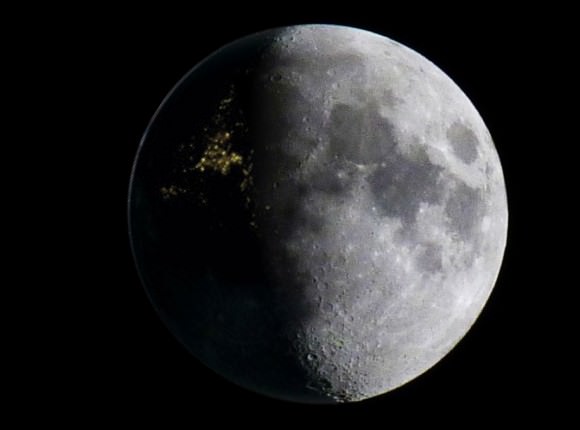
In 1936, American writer C.L. Moore wrote Lost Paradise, one of several novels that take place in her “Northwest Smith” universe, which centers on a spaceship pilot and smuggler living in a colonized Solar System. In this novel, she presents the Moon as a once-fertile place, and describes how it gradually became an airless wasteland. In 1945, British novelist and academic C. S. Lewis released That Hideous Strength, in which the Moon (Sulva) is described as being home to a race of extreme eugenicists.
Arthur C. Clarke wrote several novels and short stories that included lunar colonies between the 1950s and 1970s. In 1955, he wrote Earthlight, in which a lunar settlement is caught in the crossfire as war erupts between Earth and an alliance between Mars and Venus. In 1961, A Fall of Moondust was published, where a tourist cruiser (Selene) sinks into a sea of Moon dust.
In 1968, Clarke’s seminal novel 2001: A Space Odyssey was released, part of which takes place on a colonized Moon where a mysterious monolith is found (known as the Tycho Magnetic Anomaly, or TMA-1). Rendezvous with Rama, released in 1973, also makes mention of a colonized Moon, which is part of Solar System-spanning polity known as the United Planets.
Robert A. Heinlein also wrote extensively about human settlement on the Moon. One of his earliest was The Rolling Stones (1952), which centers on an exceptional family (the Stones) that lives on a settled Moon, but chooses to leave in order to explore the Solar System. In 1966, he released the Hugo Award-winning novel The Moon Is a Harsh Mistress, in which a largely subterranean lunar colony supplies Earth with food and minerals.
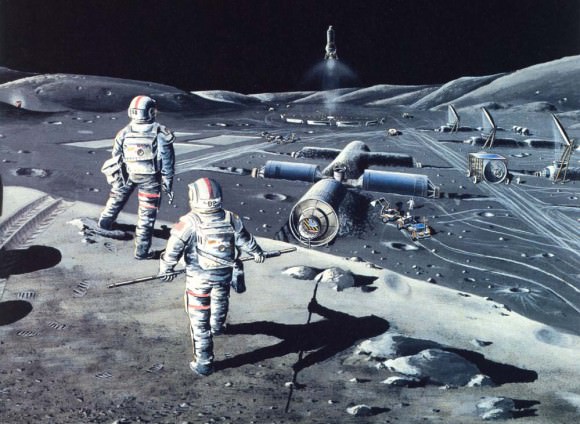
The population, known as “Lunies”, are mostly the descendants of convicts (particularly political prisoners) who live under an Earth administration. With the help of an artificial intelligence, a group of independence-seekers launch a revolt and wrest their independence from Earth. A third installment, The Cat That Walked Through Walls (1985) takes place on a Free Luna several years later.
In 1988, Kim Stanley Robinson released The Lunatics, which deals with a group of enslaved miners forced to work under the lunar surface who launch a rebellion. And in the short story “Byrd Land Six” (2010), British author Alastair Reynolds describes a Moon colony that is based around the mining of helium-3. The list goes on, with literally hundreds (if not thousands) of examples of humans living on the Moon in the near and distant future.
Study of Lunar Settlement:
Over the course of the past few decades, numerous proposals have been made for constructing a colony (or colonies) on the Moon. Most arose with the advent of the Space Age and the Apollo Program. And in more recent years, with proposals to return to the Moon by the 2020s, there has been renewed interest in creating a permanent settlement. However, there are some scientific proposals that predate the 20th century.
For example, in 1638 Bishop John Wilkins – an English clergyman, naturalist, and member of The Royal Society – wrote A Discourse Concerning a New World and Another Planet, in which he predicted a human colony on the Moon. Famed Russian rocket and astronautics scientist Konstantin Tsiolkovsky (1857-1935) – who first proposed the concept of a Space Elevator – also suggested that a lunar settlement would be a major step in humanity becoming a space-faring species.
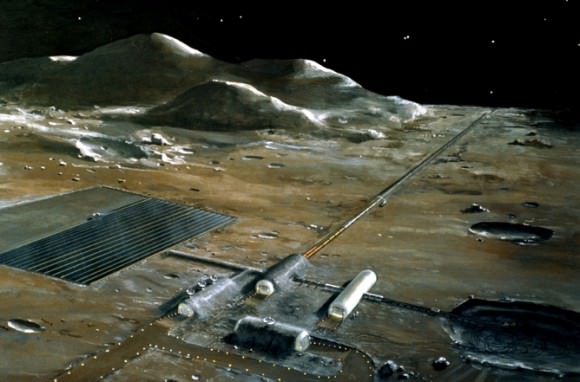
By the 1950s and 60s, proposals began to snowball with the establishment of the Apollo Program, where plans for placing astronauts on the Moon naturally led to ideas for creating permanent bases and even settlements there. In 1954, Arthur C. Clarke proposed that a lunar base could be created using inflatable modules that would then be covered in lunar dust for insulation.
Initial settlement would involve astronauts building igloo-like structures and an inflatable radio mast, which would be followed by the establishment of a larger, permanent dome. His proposal also called for air purification provided by an algae-based filter, a nuclear reactor to provide power, and electromagnetic cannons (i.e. mass drivers) launching cargo and fuel to interplanetary vessels in space.
In 1959, John S. Rinehart – the director of the Mining Research Laboratory at the Colorado School of Mines – published a proposal titled “Basic Criteria for Moon Building,” in the Journal of the British Interplanetary Society. This concept for a “floating base” consisted of a half-cylinder with half-domes at both ends and a micrometeoroid shield placed above the base. This concept was based on the then-accepted theory that there were oceans of dust on the Moon which were up to a kilometer and a half (1 mi) deep in some areas.
Several plans also emerged during this era for military installations on the Moon. These included Project Horizon (1959), a plan by the US Army to build a fort on the Moon by 1967. The US Air Force also proposed the Lunex Project in 1961, which envisaged the creation of an underground air force base on the Moon by 1968.
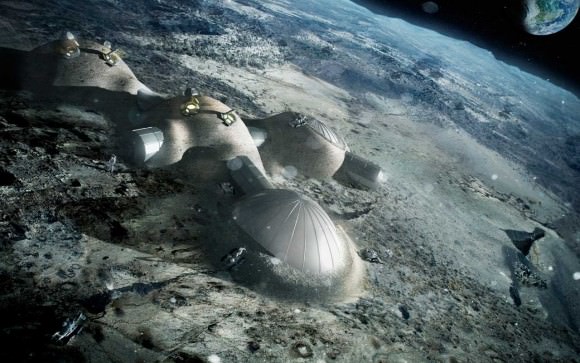
In 1962, John DeNike (the Program Manager for NASA’s Advanced Programs) and Stanley Zahn (Technical Director of Lunar Basing Studies in the Martin Company’s Space Division) published a proposal titled “Lunar Basing”. Their concept called for a sub-surface base located at the Sea of Tranquility, which would rely on nuclear reactors for power and an algae-based air filtration system.
In more recent years, multiple space agencies have drafter proposals for building colonies on the Moon. In 2006, Japan announced plans for a Moon base by 2030. Russia made a similar proposal in 2007, which would be built between 2027-32. In 2007, Jim Burke of the International Space University in France proposed creating a Lunar Noah’s Ark to ensure that human civilization would survive a cataclysmic event.
In August of 2014, representatives from NASA met with industry leaders to discuss cost-effective ways of building a Lunar base in the polar regions by 2022. In 2015, NASA outlined a concept for lunar settlement that would rely on robotic workers (known as Trans-Formers) and heliostats to create a lunar settlement around the Moon’s southern polar region. And in 2016, Johann-Dietrich Wörner, the new Chief of ESA, proposed an international village on the Moon as the successor of the international space station.
Potential Methods:
When it comes to terraforming the Moon, the possibilities and challenges closely resemble those of Mercury. For starters, the Moon has an atmosphere that is so thin that it can only be referred to as an exosphere. What’s more, the volatile elements that are necessary for life are in short supply (i.e. hydrogen, nitrogen, and carbon).
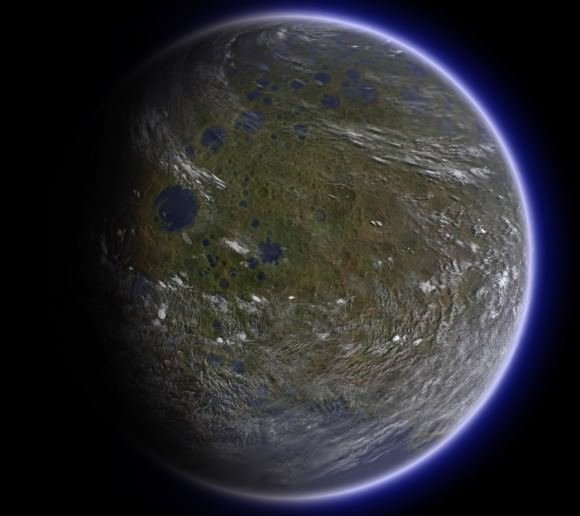
These problems could be addressed by capturing comets that contain water ices and volatiles and crashing them into the surface. The comets would sublimate, dispersing these gases and water vapor to create an the atmosphere. These impacts would also liberate water that is contained in the lunar regolith, which could eventually accumulate on the surface to form natural bodies of water.
The transfer of momentum from these comet would also get the Moon rotating more rapidly, speeding up its rotation so that it would no longer be tidally-locked. A Moon that was sped up to rotate once on its axis every 24 hours would have a steady diurnal cycle, which would make colonization and adapting to life on the Moon easier.
There is also the possibility of paraterraforming parts of the Moon in a way that would be similar to terraforming Mercury’s polar region. In the Moon’s case, this would take place in the Shackleton Crater, where scientists have already found evidence of water ice. Using solar mirrors and a dome, this crater could be turned into a micro-climate where plants could be grown and a breathable atmosphere created.
Potential Advantages:
Compared to other planets and moons in the Solar System, there are several advantages to colonizing and terraforming the Moon. The most obvious is its proximity to Earth. Compared to Mars, Venus, Mercury, or the outer Solar System, the cost and the time it would take to transport people and materials to and from the Moon would be significantly lower.
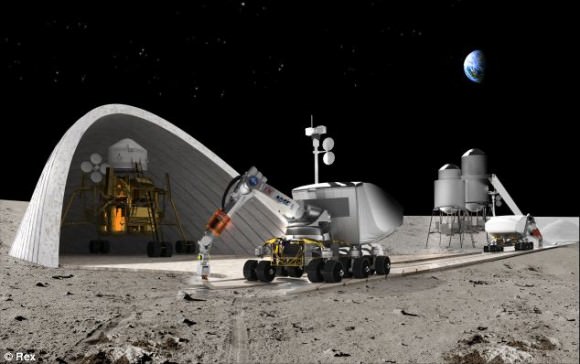
In addition, bombarding the surface with comets could deliver both an atmosphere and the momentum needed to spin the planet up to an Earth-like cycle. Compared to planet’s like Mars and Venus, it would also take significantly less comets in order to accomplish this – an estimated 100 versus several thousands.
The presence of water ice in the Lunar soil, and the large caches around the southern polar region, would also allow for the creation of surface water (once a greenhouse effect was triggered). Along with comets bombarding the surface, this could be done by introducing methane and ammonia ices, which could be harvested from moon’s like Titan and the Kuiper Belt. Overseeing the terraforming efforts would also be easier thanks to the Moon’s proximity, and require far less infrastructure.
In the meantime, colonies on the Moon would offer multiple advantages. The local resource base would provide opportunities for in-situ resource utilization, as well as raw materials needed for missions deeper into space. For instance, since the Moon is similar in composition to Earth, it has an ample supply of minerals that could be mined for use back on Earth. Lunar regolith harvested from the surface could be used to create radiation shielding and domed settlements on the surface.
The Moon’s supply of water ice, which is particularly abundant in the southern polar region, would also serve as a steady source of water for colonists. Helium-3 could easily be harvested since it is abundant in the upper layer of the Moon’s regolith for use in fusion reactors, providing a clean and steady supply of energy both for lunar colonies and Earth.
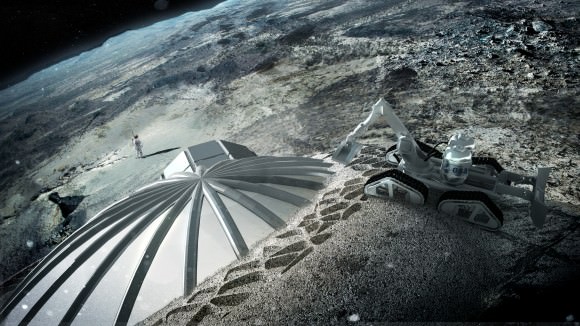
A lunar base could also serve as a stopover point for missions further into the Solar System. NASA has estimated that by creating a lunar outpost that could utilize local water to create hydrogen fuel, billions of dollars could be saved. Such an outpost would also be an intrinsic piece of infrastructure when it comes to mounting manned missions to Mars, and in the construction of a Martian settlement.
The Moon’s lower gravity and escape velocity also mean that missions launched from the Moon would require far less propellant to reach space. This same advantage could allow for the construction of a mass driver, a Lunar Elevator, or other projects that are considered too expensive or challenging to build on Earth. Such a structure would reduce the costs of moving materials and satellites (such as space-based solar power arrays) even cheaper.
Last, but not least, the creation of a lunar settlement could also yield valuable information, particularly about the long-term effects of living in a lower gravity environment. This information would prove useful towards the establishment of a permanent base on Mars or other Solar System bodies where the surface gravity is less than 1 g.
The presence of stable lunar lava tubes that are large enough to house whole cities is also an advantage. These subterranean environments could be pressurized to create a breathable atmosphere and would provide natural shielding against solar radiation.

Potential Challenges:
Terraforming the Moon is also fraught with its share of challenges. For one, harvesting comets and/or ices from the outer Solar System would require infrastructure that does not yet exist, and would be very expensive to create. Basically, hundreds of spaceships would be needed to haul all the resources, and they would have to be equipped with drive systems that could make the trip in a short amount of time (which also don’t exist yet).
While extended periods of time spent in microgravity environments is known to cause muscle degeneration and loss of bone density, it is unclear what the effect of low-gravity would be for permanent residents and children born in such environments. It has been suggested that terrestrial plants and animals could be genetically engineered to live in the lunar environment, but it is unclear whether or not this would be successful.
And of course, the cost of all of this would be astronomical, and would require a multi-generational commitment given the amount of time needed to convert the Moon’s ecology. As such, it is unlikely that any commitments made by a government or international body could be maintained between one generation and the next.
For a surface colony, there are also many challenges. The long lunar nights (354 hours long) would means that reliance on solar power would be impeded in any location other than the polar regions. In addition, the significant variations in temperature would be something colonies would have to be built to withstand. Solar radiation would also be an issue in any settlement located on the surface.
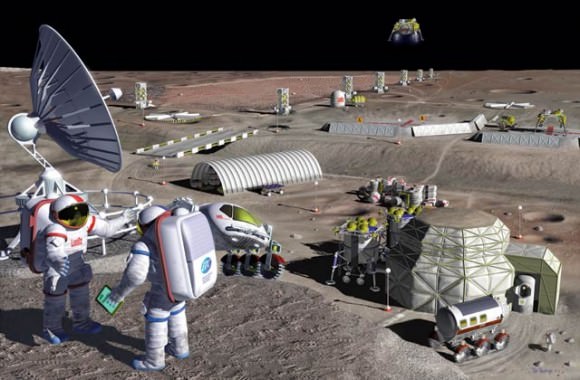
The lack of an atmosphere increases the chances of the surface being struck by comets and exposure to Solar Flares. The Moon also passes through the magnetotail of the Earth periodically, creating a plasma sheet that whips across the surface. On the light side, bombardment by electrons causes the release of UV photons and a building up of a negative charge on the dark side. This could be hazardous to any settlements on the surface.
As noted, some of these issues could be resolved by building settlements under the surface. However, assuming these settlements were reliant on solar power, they would need to be built close to the polar regions in order to take advantage of the near-perpetual light in these regions. The alternative would be to build fusion reactors which could use locally-sourced helium-3. And here too, the cost and time needed to build such a settlement would be very high.
Once again, we are forced to asked why, given all the challenges involved, should such an undertaking should be made? In the case of the Moon, the answer is quite simple. In this case, terraforming and colonization can be done cheaper, easier, and in much less time. What’s more, the advantages of having a human presence on the Moon are numerous, and include some rather lucrative aspects such as helium-3 harvesting, lunar mining, lunar solar operations, and even the creation of a lunar tourist industry.
But perhaps most importantly, a human presence on the Moon (which we’ll like call Luna if and when one exists) could easily serve as a stepping stone towards creating a human presence on Mars, Venus, and elsewhere in the Solar System. With facilities in place to provide refueling, resupply, and repairs, the costs of sending ships deeper into space would be cut dramatically.
One more step in the quest to make humanity an interplanetary – and maybe even interstellar – race!
We have written many interesting articles about terraforming here at Universe Today. Here’s The Definitive Guide To Terraforming, Should We Terraform Mars?, How Do We Terraform Mars?, How Do We Terraform Venus?, and Student Team Wants to Terraform Mars Using Cyanobacteria.
Also, be sure to check out Yes, There’s Water On The Moon and Water On The Moon Was Blown In By Solar Wind.
We’ve also got articles that explore the more radical side of terraforming, like Could We Terraform Jupiter?, Could We Terraform The Sun?, and Could We Terraform A Black Hole?
For more information, consult NASA’s Lunar Colonization – Energy and Power and Life On The Moon.


Or extensively tunnel? Leave 10ft of regolith everywhere with the occasional skylight and some domes for growing things? I mean if we have the engineering to maneuver a hundred comets we could so some serious tunneling.
Then crash the comets, then pump it all in….
Or… can we think bigger? How about merge Ceres and the Moon? Or Europa?
BTW since gravity is the problem and it is a particle there aught to be SOME interaction that favorably produces gravitons…. Course we’d have to move the Moon a bit farther out perhaps…
Agree on the tunnel idea. The whole surface can be built with existing masses to a large honeycomb pattern of atmosphere and water oasis. We would also need a super superconducting coil around the moon to protect us from energetic ions.
The object to terraforming is that we won’t need to ram comets into the object constantly to get it habitable and then to maintain its habitability. The point is to build a city without having it be at ground zero of a comet impact to maintain the place. It gets kind of expensive to keep telling residents “it’s time to move!”
So with that in mind, I will propose building a domed city inside of a cater at the moon’s North pole. The majority of the city will be underground. We’ll be able to mine the moon’s resources to provide energy and water. The mining of resources will provide the building blocks for a robust lunar economy that will justify the costs of starting a project on this scope. Oh yeah. Capitalism at it’s best.
I know its a long time until the earth becomes uninhabitable and even longer to the sun goes supernova. But assuming the human race lives that long, what does it take to survive the supernova? We obviously need to move at least to the outer solar system, dig out a huge a bunker in the core of Pluto or something, but will the solar system remains be a livable place in proximity to a white dwarf? Will there be any water left?
Do we need to travel all the way to another star and start terraforming there? If so, how far is it to the nearest new earth candidate? What does it take to travel there? Obviously orders of magnitude more money and energy then the humans have had through all our history, by hey, we have a long time to save up, with compound interest.. 🙂
Terraforming any of them, Moon, Venus or Mars, seems like a waste of time if you can’t add a magnetic field. (IDK how you do that, even in sci-fi.) You won’t be able to enjoy the lovely new temperatures and atmosphere because of solar (and maybe also cosmic) radiation. You’ll have to live, work and play in caves anyway, so why not just pressurize those and leave the surface alone?
Orbital colonies are all around better. We could have built them with 1960’s technologies. Existing 21st century tech would be even better. Cheaper & much quicker & more efficient use of materials than terraforming, too.
Not to mention gravity. We don’t know the effects of living without 1G. Low gravity as found on the moon or Mars might not be conducive to health. Venus has better gravity, but it’s really, really hot. It’ll take idk, centuries maybe to radiate off that heat. OTOH, you can have whatever “gravity” you want in an orbital colony. You’d probably even have gradations, so some standard earth like gravity, some low, some micro-gravity, and even free fall (step outside).
We don’t NEED planets. I’d say, we don’t even want them. Orbitals are better.
I wonder if adding a monstrously thick ozone layer could compensate for the lack of a magnetic field.
Bo Zo: I agree totally, we should not be moving to other planets. Movable rotating space colonies make a lot more sense in my opinion, and we have the technology to do it. Use the moon for resources to start building them. Protect them with thick hulls, magnetic fields, rotate them for 1g, give them the power to move. The power can come from the sun. It’s cheaper, more sustainable, and safer. Start in low earth orbit and work our way to the outer reaches of the solar system and beyond. How doesn’t this make more sense that plunking ourselves down on another immovable target for the next extinction event sized meteor or comet to blast us? Make the colony movable so you can avoid incoming bigger objects, learn how to deflect the smaller ones.
One advantage to the lower gravity moon is that we should finally be able to get our flying cars to work. 😉
We should utilize the Lava tubes on the Moon seal them and pressurize them and build domes on some of the almost perfect craters it would look so cool from Earth with all the Moons lights turned on in the night sky….
The Moon is the next logical stop . Not Mars !!!
Together with the space elevator and a revolving Space Station !!!
That is the way to go !!
We could probably build a space elevator on the moon with existing technology. Combine that with lava tube colonies, polar mining for ice, and domed crater cities, all tied together with a high speed monorail.
One issue with a Space Elevator to the Moon is that the moon isn’t in geosynchronous orbit.
There are no proposals for a Space Elevator to the Moon. A space elevator reaches into geostationary orbit (approx 35,000 km in altitude). It doesn’t come close to reaching the Moon, which is over ten times this distance. A Lunar Elevator, in contrast, extends from the Moon into Earth’s gravity well.
“Could We Terraform the Moon?”
A much more important question is, “Should We Terraform the Moon?”
Most assuredly not! We’ve done enough damage already to our home planet. We should learn to live with nature, not to dominate it!
If you were talking about Antarctica, or a rainforest, or Pittsburgh, I’d agree with you 200%. But environmentalism isn’t appropriate outside of an “environment.” The moon is worse than the worst desert you can’t imagine – dead, dry, cold, hot, heavily irradiated. There’s (most probably) not a single bacterium up there to inconvenience through human activity. You couldn’t “harm” the moon by paving it with radioactive dioxins.
I’d say there’s nothing on earth more important than preserving the ecology; and nothing less important in space or on the moon.
Shifting mining and energy and other polluting industries to space is a GREAT way to preserve earth’s ecology.
The tides raised by the Earth on the Moon would be about 36 times higher than the ones raised by the Moon on the Earth. That means you wouldn’t want any bodies of water on the Moon bigger than the Great Lakes in America, which here have “tides” about two inches high, but on the Moon would be about six feet.
Even if you did manage to get a decent atmosphere, it wouldn’t last. I’m not sure it would be possible to get enough of an atmosphere to have a similar air pressure as Sea-level Earth. Crashing comets might do it, but we would have to steer comets towards the Moon and even if we managed to do that, a comet impact would be hard to control.
Long term settlements will have to be underground, and/or protected by domes.
Terraform the moon? LOL! You so funny… mess with the gravitational equilibrium? No thanks, we’re not even close to knowing what unexpected variables might come into play.
BUT, if you want to talk terraforming.. let’s talk about Mars. It has recently been determined that the moon’s gravitational influence on the Earth’s core helps drive our magnetic field. Now if we could get say Ceres in orbit around Mars in just the right inclination and distance, maybe we could ‘fire up’ Mars’ magnetic field? THEN we could keep an atmosphere viable and long lived? Hmmm.. Got volcano’s? Talk about your “unexpected variables”! But maybe a little volcanic activity would he helpful?
It would take a 600 km diameter nitrogen rich (0.5%) Kuiper belt object to spin up the Moon to a 24 hour day – and give it enough nitrogen, and lots of water, average 1.3 km deep, the atmosphere would last for thousands of years but the water would react with the very dry crust.and the pure iron to make iron oxide, crust would swell, all sorts of nasty reactions. Photosynthesis would take about 100,000 years to make a breathable atmosphere and plants need to work six times harder to create the same partial pressure of oxygen as on Earth – better for a future with abundant power from fusion power or similar to split the molecules.
The 100 comets is based on Gregory Benford’s ideas, in turn coming from Landis. This is based on the old value of the size of Halley’s comet. However, it doesn’t allow for a buffer gas – a pure oxygen atmosphere would be a fire hazard. Idea is pure oxygen at a tenth of Earth’s pressure.
Gregory Benford’s spin up calculation is just a mistake. His 100 Halley comets would hardly change its angular momentum at all.
For those suggesting use of a magnetic field, it makes no difference. It would lose nitrogen and CO2 through ordinary jeans escape, it doesn’t need solar wind to strip it. Happens over a time period of thousands of years.
If the atmosphere is very thin the solar wind can strip it, happens on a timescale of 100 days so very fast. A magnetic field could help at that point. But if you can get up to a thick atmosphere it stays for 1000s of years and the solar wind can’t strip it fast enough to be significant.
A much easier approach is paraterraforming. After all you only need air within the first few meters of the surface of the Moon for breathing and plants.
Incidentally the hard vacuum of the current moon is an asset. It is far harder than for our best chip manufacturing plants on Earth. It might be that we move them to the Moon – light weight export, the factories already cost a billion dollars. The vacuum is also great for maglev, for telescopic observation. The craters at the luanr poles are natural cryogenic facilities at the temperature of liquid nitrogen, great for instance for a natural passively cooled seed vault and maybe other things too – the coldest place in the inner solar system. The far side of the Moon is shielded from Earth’s radio waves in its tidally locked position, great for radio astronomy. It’s actually got rather a lot going for it as it is, combine that with settlement in the lunar caves, probably 100 km long and may be as wide as 5 km in diameter – maybe we don’t need to terraform it any time soon, just gradually paraterraform bit by bit.
https://www.quora.com/Can-we-terraform-the-moon-If-yes-how-difficult-is-it-Is-it-possible-with-the-current-technology-and-what-are-the-major-challenges-might-we-face-while-terraforming